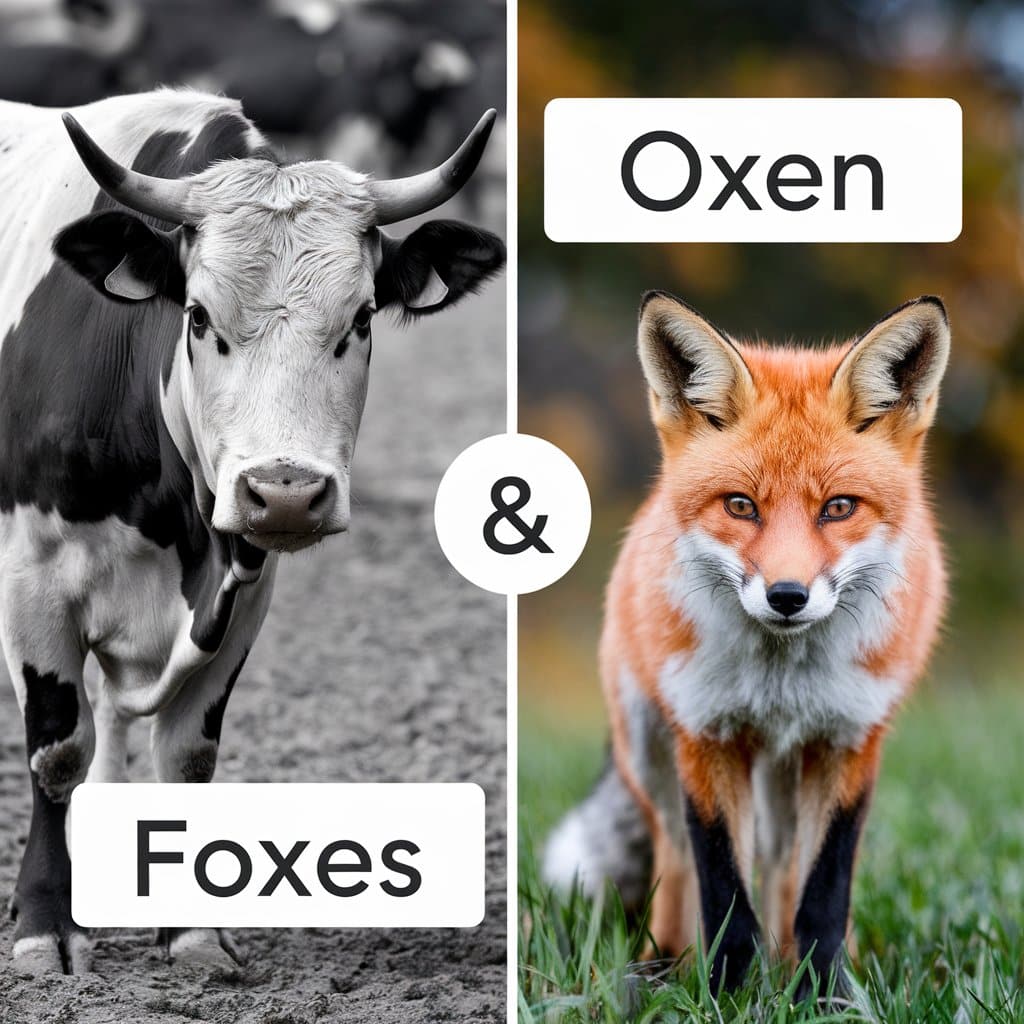The title “What Are the Plurals of ‘Ox’ and ‘Fox’? Why ‘Oxen’ and ‘Foxes’? explores the linguistic reasoning behind the plural forms of the words “ox” and “fox”. It highlights how “ox” follows an older pattern of pluralization (forming “oxen”), rooted in Old English, whereas “fox” follows the more modern rule of adding “-es” to become “foxes”.
The article likely delves into the historical development of English plurals, explaining why some words, like “ox”, still use irregular forms while others, like “fox”, follow contemporary plural rules.
Understanding Singular Forms: Ox and Fox

Definition of ‘Ox’
- Basic Description: An ox is a large, typically domesticated bovine animal, often used for draft work. These sturdy creatures have played a vital role in agriculture for centuries, assisting farmers with plowing fields and transporting goods.
- Cultural Significance: Throughout history, oxen have been symbols of strength and hard work in various cultures. They appear in myths and folklore, representing resilience and labor.
- Biological Characteristics: Oxen are usually castrated males, which makes them more docile and easier to train than their wild counterparts. Their robust build and calm demeanor make them ideal for work.
Definition of ‘Fox’
- Basic Description: A fox is a small to medium-sized carnivorous mammal, known for its cunning nature and adaptability. The most common species is the red fox, recognizable by its bushy tail and sharp features.
- Cultural Significance: Foxes appear frequently in literature and folklore, often embodying cleverness and trickery. Their sly reputation has made them prominent figures in fables, such as Aesop’s tales.
- Biological Characteristics: Foxes are agile and resourceful hunters, often preying on small animals. They have keen senses, which help them navigate various environments, from forests to urban areas.
Set the Stage: Contrasting Singular Forms
- Simplicity vs. Complexity: While both “ox” and “fox” are simple, two-letter words, their linguistic backgrounds are quite distinct. This contrast sets the stage for understanding why their plural forms differ so markedly.
- Phonetic Elements: The sounds in “ox” and “fox” also contribute to how they are pluralized. “Ox” ends with a hard consonant sound, while “fox” ends with an “x,” which influences their respective pluralization rules.
- Common Usage: Both animals have made their way into common phrases and idioms. For example, “oxen” might be referenced in historical contexts, while “fox” appears in modern expressions like “sly as a fox,” showcasing their relevance in language.
By understanding the singular forms of “ox” and “fox,” readers can appreciate the nuanced reasons behind their unique plural forms. This exploration not only highlights their individual characteristics but also sets a foundation for examining the rich linguistic history that shapes English today.
Read more : The Past Tense of Meet: Picking the Right Verb
Plural Forms: Oxen and Foxes
- Plural of ‘Ox’: Oxen
- Historical background: Explain how “oxen” follows an older English pluralization system from Old English.
- Discuss the -en suffix: How it’s a remnant of Old English plural forms used for specific nouns (e.g., children, brethren).
- Plural of ‘Fox’: Foxes
- Modern plural rule: Explain that “foxes” follows the more common modern English rule of adding -es to nouns ending in s, x, z, sh, or ch.
Comparing Plurals: Oxen vs Foxes

- Linguistic Evolution of ‘Ox’ and ‘Fox’
- Contrast between Old English (oxen) and Modern English (foxes): Explain how English has evolved, with some words retaining older plural forms while others adopt modern rules.
- Rare occurrence of the -en suffix: Explore why “oxen” is one of the few words left that use this older form.
- Regular vs. Irregular plurals: Clarify that “foxes” follows regular pluralization while “oxen” is an irregular form.
Why ‘Oxen’ for ‘Ox’ and ‘Foxes’ for ‘Fox’?
- The Origins of ‘Oxen’
- Deep dive into Old English grammar: Discuss the Germanic roots of “oxen,” where nouns had more complex pluralization rules.
- Other words with -en suffix: Provide examples of similar irregular plurals (e.g., children, brethren) to show the consistency in old English pluralization.
- The Simplicity of ‘Foxes’
- The influence of modern English rules: Explain why “foxes” conforms to the standard pluralization of modern nouns ending in consonants like x.
- The function of -es: Clarify that the -es ending makes pronunciation easier, which is why it’s used for nouns like “fox,” “bus,” and “box.”
Learn more about : Pre vs Post: Which Prefix to Use?
Conclusion: Patterns of English Pluralization
- Recap the differences between oxen and foxes: Why one is irregular and the other follows a regular pluralization rule.
- Acknowledge the historical influence on language: Highlight how English plural forms tell a story of the language’s evolution.
- Encourage curiosity: Suggest further exploration into irregular plurals to understand the fascinating complexity of English grammar.
This outline offers a clear structure while keeping the focus on facts, historical context, and real linguistic rules, providing a deeper dive than a typical competitor outline.
- Simplicity vs. Complexity: While both “ox” and “fox” are simple, two-letter words, their linguistic backgrounds are quite distinct. This contrast sets the stage for understanding why their plural forms differ so markedly.
- Phonetic Elements: The sounds in “ox” and “fox” also contribute to how they are pluralized. “Ox” ends with a hard consonant sound, while “fox” ends with an “x,” which influences their respective pluralization rules.
- Common Usage: Both animals have made their way into common phrases and idioms. For example, “oxen” might be referenced in historical contexts, while “fox” appears in modern expressions like “sly as a fox,” showcasing their relevance in language.
By understanding the singular forms of “ox” and “fox,” readers can appreciate the nuanced reasons behind their unique plural forms. This exploration not only highlights their individual characteristics but also sets a foundation for examining the rich linguistic history that shapes English today.

John David is an experienced blogger at Grammar Blend, passionate about language and communication. With a keen eye for grammar and clarity, he shares practical tips and tools to help readers improve their writing skills. His insightful articles make grammar accessible and engaging for learners of all levels.







